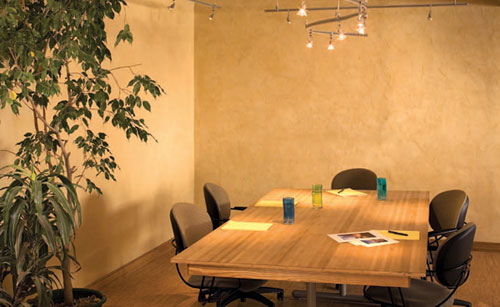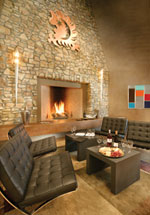The Greening of Color and Texture
Getting to Green
While green building projects are a desirable goal, in some areas environmentally sound building practices have been slow to catch on. A few architectural firms are jumpstarting the process with their own offices.
In Indiana, green building has been slow to catch on for both political and practical reasons. "Electricity in the state is among the cheapest in the country," notes Jill Mendoza, president of Indianapolis-based commercial interior design firm i.d.o. Incorporated - Innovative Design Offerings. "Plus, one of the largest incinerators in the Midwest is in Indianapolis, which takes the pressure off landfills." Further hampering demand for green building is the state's lack of incentives to motivate developers. Only six projects statewide have achieved LEED certification. Mendoza decided the firm couldn't afford to wait, and set about to make its office a model of green building. Paint played a big part both in terms of color and environmental friendliness. "Five to 10 years back, there were mostly pastels available in our low-VOC products," says Mendoza. "Today, paints can be made in the low-VOC formulations, so there's the option of bright, vivid shades that invigorate spaces." The clear, crisp colors infuse the space and its inhabitants with energy and inspiration, an outcome they anticipated but didn't formulate. "As designers, we're aware of the psychological aspects of color, but those were the icing on the cake, not the driving force behind our selections," she adds. The designers also inherited elements from which they had to work backwards. More than twothirds of the furniture and furnishings in the new building came from their old offices - including such signature eye-poppers as perky green conference-room chairs - earning i.d.o. LEED credits under the category "Resource Reuse." A brand-identity process undertaken in 2001 and its resulting color scheme similarly exerted influence. New picks, such as brown-toned cork flooring, won a LEED nod under "Rapidly Renewable Materials."
"When people walk in, they can't quite put their finger on what makes the space feel like it does," says Mendoza. "It's the color, combined with the fact that we're pushing 30 percent more fresh air through the system, we're emitting more natural light with colors reflecting that light, and we've used natural products so there aren't fumes in the air. Integrating all those elements, you're in a more natural environment."
In Albuquerque, New Mexico, design firm Environmental Dynamics, Inc. (EDI) was also interested in becoming a model of green building for the community. For their own office - LEED Gold certification is expected - the firm selected a one-story building in a neglected neighborhood. Besides reusing the existing shell and occupying half of it, EDI purchased primarily reused or salvaged materials. Partner Stace McGee, LEED AP, is a particular fan of the building's exterior lime plaster system using recycled glass for the aggregate. "The lime plaster draws water out of the wall, as opposed to a Portland system which retains the water in the wall system." The aggregate for the stucco system is from the city's recycled glass, which was washed, crushed and added to the exterior lime plaster. "We're looking at a material that is 88 percent post consumer recycled content," says McGee. "It helps decrease the embodied energy of the building, and the materials were taken from within a 500-mile radius of the site."
 |
Earthen plaster graces the walls of this conference room at Albuquerque, NM design firm, Environmental Dynamics, Inc. (EDI). Photo courtesy of American Clay |
Â
EDI is currently assessing the ability of the interior clay plaster to absorb a majority of the daily humidity and temperature swings inside the building - a finding that will have implications for the structure's energy consumption. EDI will compare experience in the south side of the building which was finished with earthen plaster and the north, which sports a no-VOC paint. While the research is still ongoing, the preliminary results attained between the north and south areas at EDI have led to more controlled testing. This will lead to quantifiable numbers for energy savings provided by the clay plaster.
Mixing It Up |
|||
Using multiple colors and texture in a space can do many things besides just making a statement. It can define specific areas of a space you want to draw attention to, and it can energize and provide visual stimulation promoting conversation and activity. Creating sizzling energy is what interior designer Barb Terrick did in a ninth-floor loft home in the Cork Factory, a trendy Pittsburgh loft development that was designed in the 1860s by well-known, turn-of-the-century architect Frederick Osterling. Terrick chose a unique palette of 14 colors, including chartreuse, purple, blue and copper, to soften up the space. "I chose off-the-wall colors, but I was confident they would all work," Terrick says. "You can't put run-of-the-mill colors in this loft." Originally a wide open space with 14-foot ceilings, the loft was divided by a series of 8-foot walls, creating an effect of many layered surfaces. She used bright greens and purples on the walls, along with a deep rust hue. "To do it all in one color would have been so boring and wouldn't have made the place come alive," Terrick says. At the Hospitality Center at Vina Robles winery in Central California, architect Tim Woodle, AIA, of Pults & Associates in San Luis Obispo used a mix of materials, including a handtroweled plaster walls, hand-mortared tiles, hewn timbers and two different stone profiles to foster a sense of welcome and enjoyment in the retail store, tasting room and entertainment areas. "We've created a quiet elegance with clear ties to the history of the region," says Woodle, noting that this was achieved "using building forms and proportions that are familiar and solid, yet comfortable." |
Â
Meanwhile the building, which EDI shares with the Sierra Club, the New Mexico Wilderness Alliance and Quercus Landscape Architects, is on the tour - it's made available for learning purposes to students of all ages, AIA groups, USGBC NM Chapter building tours and others interested in green building practices.
"EDI is moving beyond sustainable architecture towards regenerative design" says McGee. "Building that gives back to the environment, instead of just taking from it."
Manufacturers have responded to consumer demands with products that are increasingly environmentally friendly as well as beautiful and effective - products that have the potential to create interior and exterior surfaces that enliven, inspire, restore peace and tranquility. These products are the building blocks and tools. Put in the hands of designers and architects - that is where the alchemy begins.
Color Forecast |
According to Color Marketing Group (CMG), a leading international association of color design professionals, today's hottest color trends are most influenced by two major issues: the economy and concern for the environment. "Economic extremes lead to color extremes, too," said Jaime Stephens, executive director of CMG, which has predicted color trends for more than 45 years. "Members tell us our dual instincts apply as well to technology," she said. "We want to sit under a tree and read a book - with our BlackBerry nearby. We are drawn to old-culture décor - a Tuscan farmhouse kitchen - but we want state-of-theart appliances in that kitchen. So we are drawn to both vintage hues and new bright colors." CMG has several color predictions for Fall/Winter 2008. Purple has moved from a blue-based lavender to a red-based purple verging on raspberry, with the newest version a "highenergy almost fuchsia-like color." The Beijing Summer Olympics has inspired a taste for a "passionate orangey red." Grays will be tending toward pale and "lilac-y." Green, which has been the most-used color over the last few years, as environmentalism went mainstream, is getting some updated hues. With more than 6,000 shades of green appearing in nature, there is certainly room for change. According to CMG, "the newest greens are moving toward shades that are grayer and bluer. Green is trending away from yellow-based shades and moving toward blue-based shades. This fall, cool blue-greens will be everywhere. Some of the newest are so blue they almost read turquoise." For blues, robin's egg blues of the last couple of years will give way to paler, "spa-influenced" blue and spirited blues that are vibrant without being aggressive. CMG also calls for inky navy blues as an alternative to black. |
Â









